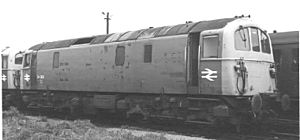British Rail Class 74 facts for kids
Quick facts for kids British Rail Class 74 |
|
 |
|
| 74 003 in BR blue with full yellow ends | |
| Power type | Electro-diesel |
|---|---|
| Builder | British Railways’ Doncaster Works; rebuilt BR Crewe Works |
| Build date | 1958–1960; Rebuilt 1967–1968 |
| Total production | 10 (rebuilt) |
| Configuration | Bo-Bo |
| UIC classification | Bo'Bo' |
| Gauge | 4 ft 8 1⁄2 in (1,435 mm) |
| Wheel diameter | 4 ft 0 in (1.219 m) |
| Locomotive weight | 77 long tons (78 t) |
| Electric system(s) | 650–750 V Direct Current |
| Current collection method | Third rail |
| Prime mover | Paxman 6YJXL |
| Traction motors | English Electric 532A, 4 off |
| Power output | Electric (continuous): 2,300 hp (1,715 kW) Electric (one-hour): 2,552 hp (1,903 kW) Engine: 650 bhp (485 kW) |
| Tractive effort | Electric: 47,500 lbf (211.3 kN) Diesel: 40,000 lbf (177.9 kN) |
| Train heating | Electric Train Heating |
| Train brakes | Vacuum, Air, Electro-Pneumatic |
| Career | British Railways’ Southern Region |
| Number | E6101–E6110 |
| Axle load class | Route availability 7 |
| Disposition | All scrapped |
The British Rail Class 74 was a special type of train engine called an electro-diesel locomotive. This means it could run using electricity from the tracks or by using its own diesel engine. These powerful engines were created in the late 1960s by rebuilding older Class 71 locomotives. They were used on the Southern Region of British Railways.
Contents
What is an Electro-Diesel Locomotive?
An electro-diesel locomotive is a very clever type of train engine. It has two ways to get power. It can use electricity from an electrical supply, like a third rail on the ground. Or, it can switch to using an onboard diesel engine when there is no electricity available. This makes them very flexible for different railway lines.
How the Class 74 Was Born
The Class 74 locomotives were not built from scratch. Instead, they were rebuilt from older Class 71 electric locomotives. In the late 1960s, British Railways decided to update these older engines. Ten Class 71 locomotives were sent to Crewe Works to be transformed. This rebuilding project happened between 1967 and 1968.
From Electric to Electro-Diesel
The original Class 71 engines only ran on electricity. But the Southern Region of British Railways needed engines that could also run on lines without electric power. So, the Class 71s were given a new diesel engine and a generator. This allowed them to work on both electric and non-electric tracks.
How the Class 74 Worked
The Class 74 could get its power from a 650–750 V DC third rail. This is a special rail next to the main tracks that carries electricity. When there was no third rail, the locomotive could switch to its Paxman 6YJXL diesel engine. This engine would then power the train.
Power and Speed
When running on electricity, the Class 74 could produce up to 2,300 hp. This made it quite powerful for its time. When using its diesel engine, it had about 650 bhp. The locomotive weighed about 77 long tons.
Life on the Tracks
These ten Class 74 locomotives were numbered E6101 to E6110. They mostly operated on the Southern Region of British Railways. Their ability to switch between electric and diesel power made them useful for different routes. They could pull both passenger and freight trains.
The End of the Line
The Class 74 locomotives had a relatively short life compared to some other trains. By the late 1970s, they began to be taken out of service. All ten Class 74 locomotives were eventually scrapped. This means they were taken apart and their materials recycled.
Images for kids



